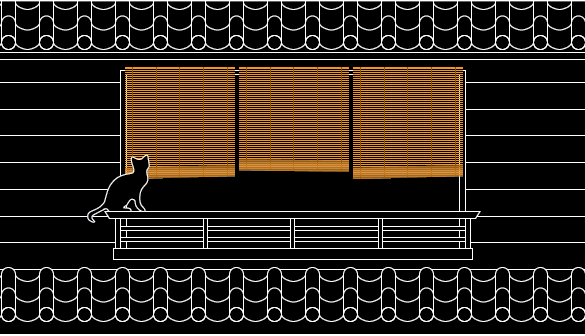It’s been some time since I posted about the differences between Japanese and Western housing and how they could constructively borrow these traits from one another. To revie the series (and this blog), I’ve written a short appreciation of an easily overlooked, yet ever present, feature of Japanese townscapes…
In his 1933 essay In Praise of Shadows Jun’ichirō Tanizaki extolled the virtue of shade and advocated for its appreciation in design and the arts. When visiting traditional homes or shrines in Japan, the provision of shade becomes quite evident. In addition to roofs with long overhanging eaves, the Japanese have long used blinds – called sudare – to create shade and privacy indoors, particularly in the hot summer months.
Contemporary architects and their clients are often fixated on creating bright, light-filled spaces. This maybe somewhat logical. After all, while you can’t create sunlight, you can certainly screen it out. While access to sunlight fulfills basic human needs – psychological as well as physiological – large expanses of south-facing glazing (in the northern hemisphere) is too much a good thing. Energy from sunlight heats the interior surfaces of the home (like a greenhouse). Even so, certain “star” architects go on flaunting this rather self-evident truth.
Before air conditioners became the norm, Japanese homes relied on simple shading (long eaves) and natural ventilation to keep cool. The sudare (簾 or すだれ) was a simple way of blocking out sunlight – as well as unwanted views, without restricting airflow. This helped create a more comfortable living environment. The sudare is essentially a blind or screen still commonly seen hanging over windows outside homes and shops everywhere in Japan, particularly in summertime.
Sudare are comprised of a row of solid stems of bamboo or other native reed plants. Twine is used to weave the row of thin sticks into a flexible sheet, which creates gaps through which light and breeze can penetrate. Unlike fixed architectural louvres, a sudare can simply be rolled and tied-up when not needed. They are lightweight and can be taken down for storage in winter.
Historically, sudare have played ceremonial role in Japanese culture. Indoors, more refined sudare, made from fine reeds, were used to create privacy partitions. For example, they could protect a young noble women from the lustful gaze of an amorous suitor, such as in the 11th century epic The Tale of Genji. Decotrative sudare are tasseled and or hemmed with silk tape. They are also used to frame artistic scrolls.
If adjusted to the right height, a hanging sudare can block views into the home, whilst allowing those seated inside to glimpse the rocks, moss, and foliage covering the garden. Often adorning teahouses, these rustic blinds create a sense of enclosure and intimacy, but without shutting out the sights and sounds of the garden.
Today, the making of authentic sudare is an endangered handicraft in Japan. But they are also mass-produced in various sizes and sold cheaply by home centers throughout the country. Being cheap, low-tech, and recyclable makes the sudare one of the easiest and most cost-effective effective energy-saving retrofits one can make to an existing home.
Could the sudare be a useful way to save energy outside Japan? Certainly (if you can find them). I’ve added a simple proprietary pulley system to the sudare I have at home, making it easy to pull them up and down whenever we want, like a big exterior blind.


